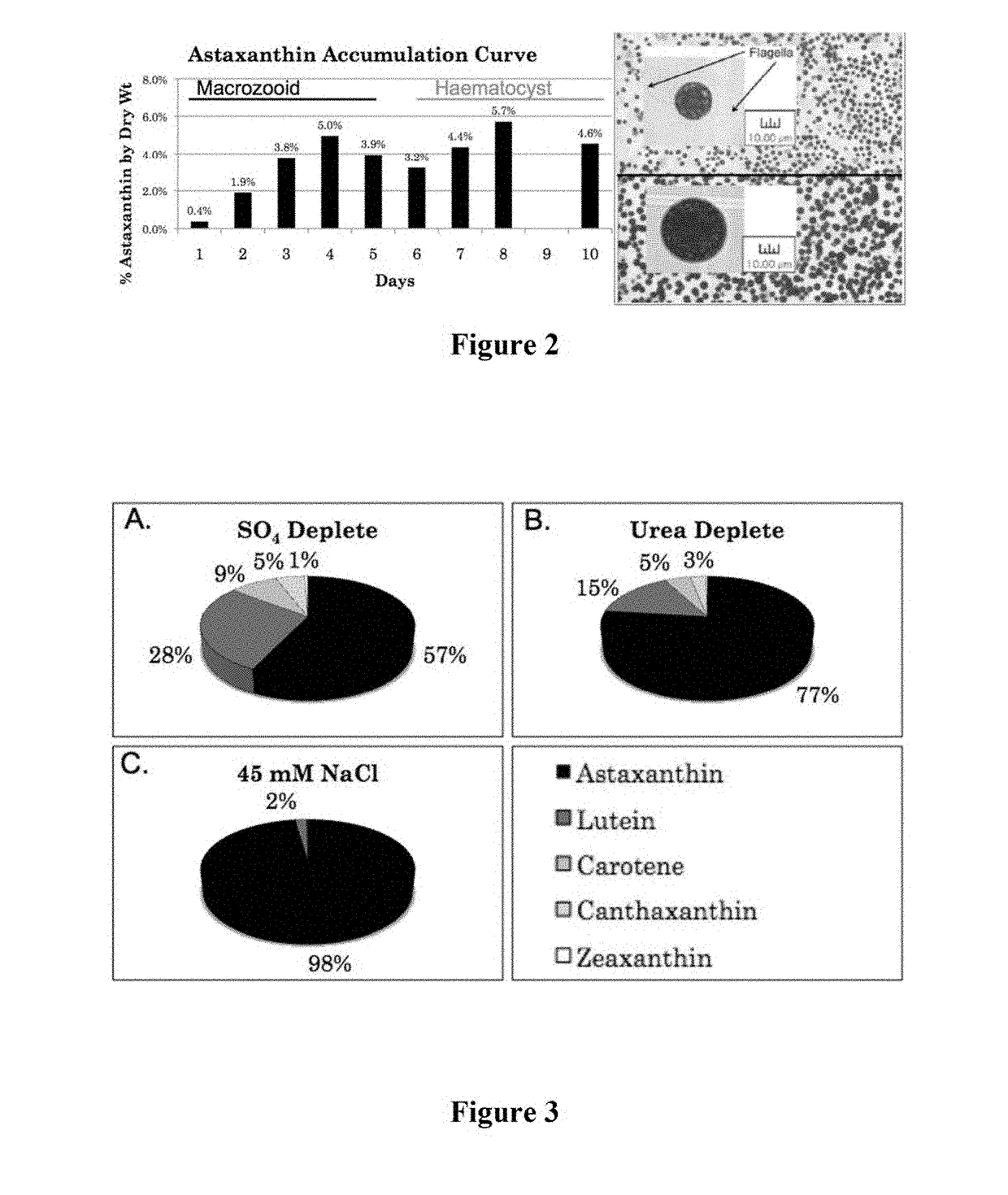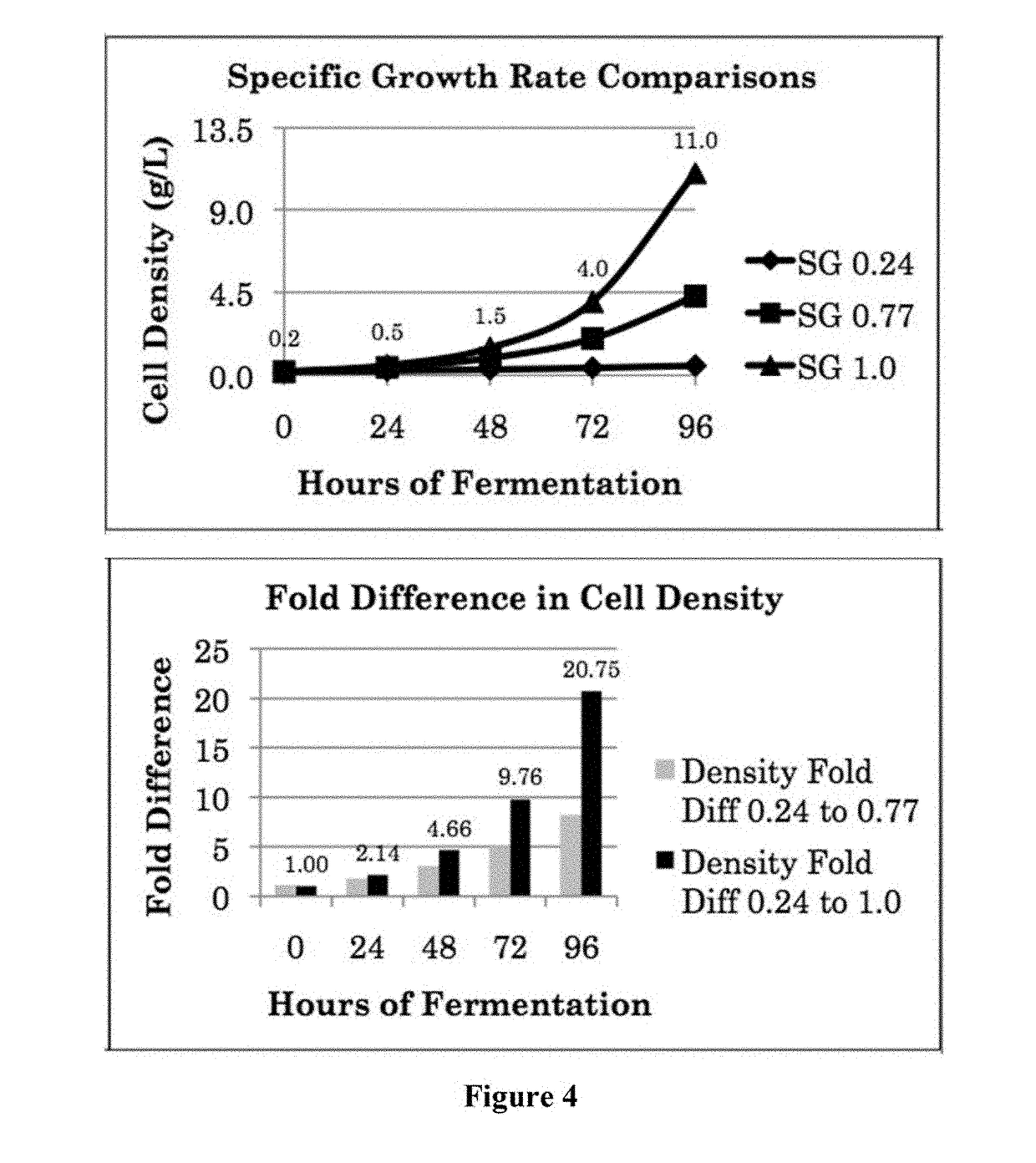Heterotrophic production methods for microbial biomass and bioproducts
- Summary
- Abstract
- Description
- Claims
- Application Information
AI Technical Summary
Benefits of technology
Problems solved by technology
Method used
Image
Examples
example 1
ment of Heterotrophic Strains and Cultures
[0201]This example is directed to novel heterotrophic cell types that are cultivated with conditions favorable to vegetative growth and making product using the method of the invention. Cells of Haematococcus are isolated as environmental samples or obtained from culture collections such as UTEX 2505 obtained from the Culture Collection of Algae at the University of Texas (Austin, Tex., USA). Cells can include isolates with higher salt tolerance such as photosynthetic Haematococcus pluvialis strain BM1 (Chekanov et al. 2014). Cells can also be obtained from commercial-scale photosynthetic production cultures. Germination of cysts or spores, if present, takes place under conditions favored to produce motile cells that divide and subdivide to produce a culture containing green motile cells. Use of an inverted microscope is effective to identify the life cycle stage (vegetative, immature cyst, cyst). To reduce initial contaminant load the cultu...
example 2
position and Temperature for Heterotrophic Growth
[0203]Medium components that produce the greatest increase in growth are identified for various species. This is performed at flask level initially, with a starting basal medium, and uses acetate as the fixed carbon source because the frequent (hourly) manual acetic acid additions are too labor intensive and would require round the clock day care. Using H. pluvialis KAS1601 as one example, the use of urea as a nitrogen source produced 40% increase in growth over KNO3 and 28° C. temperature produced 57% increase over 25° C., giving an overall 2.2-fold increase in OD750 after the same time point before stationary phase begins. Specifically, the preferred nitrogen source is determined using heterotrophic flask growth media at 25° C. consisting of a baseline medium of 1.6 g / L sodium acetate, 0.16 g / L yeast extract, 1.76 mM nitrogen (0.88 mM urea or 1.76 mM KNO3), 0.05 g / L magnesium sulfate heptahydrate, 0.05 g / L calcium chloride dihydrate...
example 3
phic Media Composition and Pigment Production by Macrozooid Cells
[0204]This example employs strains selected for preferred growth under heterotrophic conditions. Using Haematococcus pluvialis KAS1601 as an example for describing the seed train, nine 500 mL vegetative heterotrophic cultures of H. pluvialis were grown in batch culture in a 1 L flask at 25° C. with shaking at 100 rpm for sufficient time to be well into the growth phase but before entering stationary phase, as measured by cell densities having an OD750 of 0.15 in early growth phase and increasing to an OD750 of about 0.6 in late growth phase. Flask growth media consist of 0.16 g / L yeast extract, 0.11 g / L urea, 0.05 g / L magnesium sulfate heptahydrate, 0.05 g / L calcium chloride dihydrate, 0.02 g / L potassium phosphate, 0.01 g / L iron-EDTA, 0.0063 g / L iron chloride hexahydrate, 22 mg / L tetrasodium EDTA, 0.3 mg / L cobalt sulfate, 6 mg / L manganese sulfate, 0.8 mg / L zinc sulfate, 0.2 mg / L copper sulfate, 0.7 mg / L ammonium molybd...
PUM
| Property | Measurement | Unit |
|---|---|---|
| Fraction | aaaaa | aaaaa |
| Fraction | aaaaa | aaaaa |
| Fraction | aaaaa | aaaaa |
Abstract
Description
Claims
Application Information
 Login to View More
Login to View More - R&D
- Intellectual Property
- Life Sciences
- Materials
- Tech Scout
- Unparalleled Data Quality
- Higher Quality Content
- 60% Fewer Hallucinations
Browse by: Latest US Patents, China's latest patents, Technical Efficacy Thesaurus, Application Domain, Technology Topic, Popular Technical Reports.
© 2025 PatSnap. All rights reserved.Legal|Privacy policy|Modern Slavery Act Transparency Statement|Sitemap|About US| Contact US: help@patsnap.com



